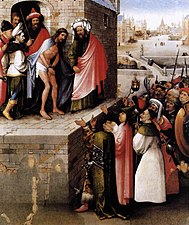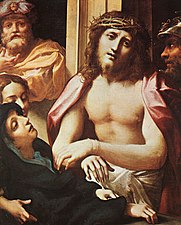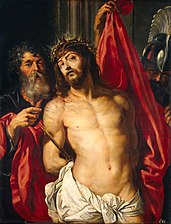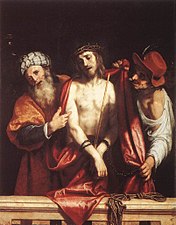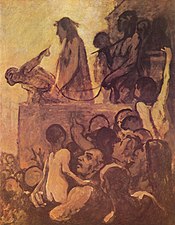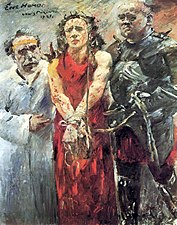Ecce Homo
Ecce homo (/ˈɛksi ˈhoʊmoʊ/, Ecclesiastical Latin: , Classical Latin: ; behold the man) are the Latin words used by Pontius Pilate in the Vulgate translation of the Gospel of John, when he presents a scourged Jesus, bound and crowned with thorns, to a hostile crowd shortly before his Crucifixion (John 19:5).
The original New Testament Greek: "ἰδοὺ ὁ ἄνθρωπος", romanized: "idoù ho ánthropos", is rendered by most English Bible translations, e.g. the Douay-Rheims Bible and the King James Version, as "behold the man". The scene has been widely depicted in Christian art.


A scene of the ecce homo is a standard component of cycles illustrating the Passion and life of Christ in art. It follows the stories of the Flagellation of Christ, the crowning with thorns and the mocking of Jesus, the last two often being combined: The usual depiction shows Pilate and Jesus, a mocking crowd which may be rather large, and parts of the city of Jerusalem.
But, from the 15th century in the West, and much earlier in the art of the Eastern church, devotional pictures began to portray Jesus alone, in half or full figure with a purple robe, loincloth, crown of thorns and torture wounds, especially on his head, and later became referred to as images of the Ecce homo. Similar subjects but with the wounds of the crucifixion visible (Nail wounds on the limbs, spear wounds on the sides), are termed a Man of Sorrows (also Misericordia). If the instruments of the Passion are present, it may be called an Arma Christi. If Christ is sitting down (usually supporting himself with his hand on his thigh), it may be referred to it as Christ at rest or Pensive Christ. It is not always possible to distinguish these subjects.
Eastern Christianity
Narrative scenes of the biblical moment are almost never shown in Eastern art, but icons of the single figure of the tortured Christ go back over a millennium, and have sometimes been called Ecce homo images by later sources. The first depictions of the ecce homo scene in the arts appear in the 9th and 10th centuries in the Syrian-Byzantine culture of the Antiochian Greek Christians.
Eastern Orthodox tradition generally refers to this type of icon by a different title: ″Jesus Christ the Bridegroom″ (Byzantine Greek: Ιηϲοῦϲ Χριστόϲ ὁ Νυμφίος, romanized: Iesoũs Christós ho Nymphíos). It derives from the words in New Testament Greek: "ἰδοὺ ὁ νυμφίος", romanized: "idoù ho nymphíos", by which Jesus Christ reveals himself, in his Parable of the Ten Virgins according to the Gospel of Matthew, as the bearer of the most high joy.

The icon presents the bridegroom as a suffering Christ, mocked and humiliated by Pontius Pilate's soldiers before his crucifixion.
The daily Midnight Office summons the faithful to be ready at all times for the day of the Dread Judgement, which will come unexpectedly like "a bridegroom in the night". On Monday, Tuesday and Wednesday, the first three days of Passion Week, the last week before Pascha, consecrated to the commemoration of the last days of the earthly life of the Saviour, the troparion is chanted: "Behold the Bridegroom Cometh at Midnight" (Byzantine Greek: Ἰδού ὁ Νυμφίος ἔρχεται ἐν τῷ μέσῳ τῆς νυκτός, romanized: idoú ho nymphíos érchetai en tõ méso tẽs nuktós).
A Passion Play, presented in Moscow (27 March 2007) and in Rome (29 March 2007), recalls the words, with which "in Holy Scriptures Christ describes Himself as a bridegroom":
The Bridegroom of the Church is transfixed with nails.
The Son of the Virgin is pierced with a spear.
We venerate Thy Passion, O Christ.
We venerate Thy Passion, O Christ.
We venerate Thy Passion, O Christ.
Show us also Thy glorious Resurrection.— Hilarion Alfeyev, The Passion according to St. Matthew
Western Christianity

Depictions of Western Christianity in the Middle Ages, e.g. the Egbert Codex and the Codex Aureus Epternacensis, seem to depict the ecce homo scene (and are usually interpreted as such), but more often than not only show the Crowning of thorns and the Mocking of Christ, which precede the actual ecce homo scene in the Bible. The independent image only developed around 1400, probably in Burgundy, but then rapidly became extremely popular, especially in Northern Europe.

The motif found increasing currency as the Passion became a central theme in Western piety in the 15th and 16th centuries. The ecce homo theme was included not only in the passion plays of medieval theatre, but also in cycles of illustrations of the story of the Passion, as in the Great Passion of Albrecht Dürer or the engravings of Martin Schongauer. The scene was (especially in France) often depicted as a sculpture or group of sculptures; even altarpieces and other paintings with the motif were produced (e.g. by Hieronymus Bosch or Hans Holbein). Like the passion plays, the visual depictions of the ecce homo scene, it has been argued, often, and increasingly, portray the people of Jerusalem in a highly critical light, bordering perhaps on antisemitic caricatures. Equally, this style of art has been read as a kind of simplistic externalisation of the inner hatred of the angry crowd towards Jesus, not necessarily implying any racial judgment.
The motif of the lone figure of a suffering Christ who seems to be staring directly at the observer, enabling him/her to personally identify with the events of the Passion, arose in the late Middle Ages. At the same time similar motifs of the Man of Sorrow and Christ at rest increased in importance. The subject was used repeatedly in later so-called old master prints (e.g. by Jacques Callot and Rembrandt), in the paintings of the Renaissance and the Baroque, as well as in Baroque sculptures.
Hieronymus Bosch painted his first Ecce Homo during the 1470s. He returned to the subject in 1490 to paint in a characteristically Netherlandish style, with deep perspective and a surreal ghostly image of praying monks in the lower left-hand corner.
In 1498, Albrecht Dürer depicted the suffering of Christ in the ecce homo of his Great Passion in unusually close relation with his self-portrait, leading to a reinterpretation of the motif as a metaphor for the suffering of the artist. James Ensor used the ecce homo motif in his ironic painting Christ and the Critics (1891), in which he portrayed himself as Christ.
Antonio Ciseri's 1871 Ecce Homo portrayal presents a semi-photographic view of a balcony seen from behind the central figures of a scourged Christ and Pilate (whose face is not visible). The crowd forms a distant mass, almost without individuality, and much of the detailed focus is on the normally secondary figures of Pilate's aides, guards, secretary and wife.

One of the more famous modern versions of the ecce homo motif was that by the Polish artist Adam Chmielowski, who went on to found, as Brother Albert, the Albertine Brothers (CSAPU) and, a year later, the Albertine Sisters (CSAPI), eventually becoming proclaimed a saint on 12 November 1989 by Pope John Paul II, the author of Our God's Brother, a play about Chmielowski, written between 1944 and 1950, when the future Pontiff and later himself a saint was a young priest. Chmielowski's Ecce Homo (146 cm x 96.5 cm, unsigned, painted between 1879 and 1881), was significant in Chmielowski's life, as it is in Act 1 of Wojtyła's play. Pope John Paul II is said to have kept a copy of this painting in his apartment at the Vatican. The original can be viewed in the Ecce Homo Sanctuary of the Albertine Sisters in Kraków. It was painted at a time when the painter was going through an inner struggle, trying to decide whether to remain an artist, or to give up painting to pursue the calling to minister to the poor.
Especially in the 19th and 20th centuries, the meaning of ecce homo motif has been extended to the portrayal of suffering and the degradation of humans through violence and war. Notable 20th-century depictions are George Grosz's (1922–1923) and Lovis Corinth's Ecce Homo (1925). The 84 drawings and 16 watercolors of Grosz criticize the socio-political conditions of the Weimar Republic. Corinth shows, from the perspective of the crowd, Jesus, a soldier, and Pilate dressed as a physician. Following the Holocaust of World War II, Otto Dix portrayed himself, in Ecce Homo with self-likeness behind barbed wire (1948), as the suffering Christ in a concentration camp.
Artworks
These are images of the narrative type, with other figures, rather than the devotional Man of Sorrows type.
- Ecce Homo (Bosch, 1470s), now Frankfurt
- Ecce Homo (Bosch, 1490s), follower of Bosch, now Indianapolis and Philadelphia
- Ecce homo (Mantegna), c. 1500, now Paris
- Ecce Homo (Caravaggio), c. 1605, Genoa
- Ecce Homo (Rubens), c. 1612 Hermitage Museum
- Ecce Homo (Luini), before 1532, Cologne
- Ecce Homo (Daumier), 1850, Essen
Gallery
- ΙϹ ΧϹ Ό ΝΥΜΦΊΟϹ
- Ecce Homo, Nuno Gonçalves, 15th century
- Hieronymus Bosch, 1470s
- Ecce Homo, Abraham Janssens, (1567–1632)
- Correggio, 16th century
- Tintoretto, 1546
- Ecce Homo, by Titian (1490–1576)
- Ecce Homo by Andrea Solario, c. 1506
- Quentin Massys, c. 1520
- Rubens, 1612
- Jan Cossiers, c. 1620
- Mateo Cerezo, 1650
- Ecce Homo, by Lodovico Cardi called Cigoli
- Ecce Homo, by Philippe de Champaigne (1602–1674)
- Ecce Homo, by Elias Moskos, 1648
- Ecce Homo, by Pedro de Mena, 17th century
- The statue of Ecce Homo, revered in Brazil as the Good Jesus
- Ecce Homo, by Pierre Mignard, (1690)
- Ecce Homo, by Honoré Daumier, (1850)
- Antonio Ciseri (1871)
- Ecce Homo, by Adam Chmielowski, 1879–1881
- Lovis Corinth, 1925
Publications
- Хальфан, Елена (30 March 2009). "Se Zhenikh gryadet v polunoshchi..." Се Жених грядет в полунощи... [Behold, the Bridegroom comes at midnight...]. Pravmir.ru (in Russian). Moscow: Orthodoxy and the World. Archived from the original on 14 February 2018. Retrieved 28 March 2019. — Rotem (29 December 2018). "Church of Holy Sepulchre: Greek Orthodox Calvary". BibleWalks.com. Holy Land sites review. Archived from the original on 10 February 2019. Retrieved 28 March 2019.
- Dreher, Rod (2017) [2015]. "The Lesson of the Reed". How Dante Can Save Your Life: The Life-Changing Wisdom of History's Greatest Poem. New York, NY: Regan Arts. ISBN 978-1-68245-073-4.
- "Christ The Bridegroom: 'Behold, the Bridegroom is coming...'". Byzantine Catholic Eparchy of Parma: Christ the Bridegroom Monastery. April 2009. Archived from the original on 1 August 2018. Retrieved 3 April 2019.
- Alfeyev, Hilarion (August 1995). "Prayer in St Isaac of Nineveh". Department for External Church Relations. Moscow Patriarchate. Archived from the original on 1 December 2008. Retrieved 22 March 2019.
- John El Massih (10 April 2017). "Bridegroom, Troparion" (Sheet music) (in English and Arabic). Antiochian Orthodox Christian Archdiocese of North America — Sacred Music Library. Archived from the original on 19 April 2019. Retrieved 19 April 2019.
- Basil Essey (14 February 2008). "Bridegroom, Exaposteilarion" (Sheet music). Antiochian Orthodox Christian Archdiocese of North America — Sacred Music Library. Archived from the original on 19 April 2019. Retrieved 19 April 2019.
- "Christus der Bräutigam" [Christ the Bridegroom] (JPEG image). 4 April 2018. Archived from the original on 1 April 2019. Retrieved 2 April 2019.
- "Christus der Bräutigam" [Christ the Bridegroom] (JPEG image). 4 April 2018b. Archived from the original on 1 April 2019. Retrieved 2 April 2019.
- "Gemeinde Wien" [Parish of Vienna] (in German). Antiochenisch-Orthodoxe Metropolie von Deutschland und Mitteleuropa. 2019. Archived from the original on 1 April 2019. Retrieved 1 April 2019.
- Alexandre (Semenoff-Tian-Chansky) (1984). Catéchisme orthodoxe (in French). Translated by Rovère, Irène (3rd ed.). Paris: YMCA Press. ISBN 2-85065-042-0. BnF 34859890h. ASIN B0014P88QS (1961. 1st ed.). ASIN B0014P9SHG (1966. 2nd ed.). — Александр (Семёнов-Тян-Шанский). "O dukhovnoy zhizni khristianina. Khristianskaya etika: Pritchi o Samom Spasitele" О духовной жизни христианина. Христианская этика: Притчи о Самом Спасителе [On the spiritual life of a Christian. Christian ethics: Parables about the Savior Himself]. Pravoslavnyy katekhizis Православный катехизис [Orthodox catechism] (in Russian). Archived from the original on 1 February 2017. Retrieved 29 March 2019.
- Slobodskoy, Serafim Alexivich (1967). The Law of God: For Study at Home and School (English translation). Translated by Price, Susan (1st ed.). Jordanville, N.Y.: Holy Trinity Monastery. ISBN 978-0-88465-044-7. Archived from the original on 27 August 2018. Retrieved 6 April 2019. — Слободской, Серафим Алексеевич (1967) [1957]. Zakon Bozhiy: Rukovodstvo dlya sem'i i shkoly Закон Божий: Руководство для семьи и школы [The Law of God: For Study at Home and School] (in Russian) (2nd ed.). Jordanville, N.Y.: Holy Trinity Monastery (published 1966). Archived from the original on 27 August 2018. Retrieved 6 April 2019. — Internet edition (Russian: Интернетское издание, romanized: Internetskoye izdaniye): 25 декабря 2005 / 7 января 2006 г., romanized: 25 dekabrya 2005 / 7 yanvarya 2006 g., lit. '25 December 2005 / 7 January 2006'.
- "Church Of All Russian Saints in Burlingame, CA". Dorogadomoj.com: The Way Home to our Father, the Lord God, and Mother Church (English translation). 19 November 2008 [31 May 2002]. Archived from the original on 6 May 2018. Retrieved 7 April 2019. — "Tserkov' Vsekh Svyatykh v zemle Rossiyskoy prosiyavshikh v g. Burlingeym, shtat Kaliforniya" Церковь Всех Святых в земле Российской просиявших в г. Бурлингейм, штат Калифорния [Church Of All Russian Saints in Burlingame, CA]. Doroga domoy k nashemu Ottsu Gospodu Bogu i materi Tserkvi Дорога домой к нашему Отцу Господу Богу и матери Церкви [The Way Home to our Father, the Lord God, and Mother Church] (in Russian). 15 September 2008 [31 May 2002]. Archived from the original on 27 August 2018. Retrieved 7 April 2019.
- "Behold, the Bridegroom cometh at Midnight" (Russian chant). Gloria.tv. 20 August 2010. Archived from the original on 4 April 2019. Retrieved 4 April 2019.
- "Bases of the Social Concept of the Russian Orthodox Church". Department for External Church Relations. Moscow Patriarchate. 16 August 2000. Archived from the original on 24 July 2008. Retrieved 22 March 2019.
- Alfeyev, Hilarion (5 March 2007). "The Passion according to St Matthew. Libretto". Department for External Church Relations. Moscow Patriarchate. Archived from the original on 27 August 2008. Retrieved 22 March 2019.
- Schiller, Gertrud (1972). Iconography of Christian Art: The passion of Jesus Christ (English translation). Vol. 2. London: Lund Humphries. ISBN 0-85331-324-5. — Ikonographie der christlichen Kunst: Die Passion Jesu Christi [Iconography of Christian Art: The passion of Jesus Christ] (in German). Vol. 2 (2 ed.). Gütersloher Verlagshaus Gerd Mohn. 1983. ISBN 3-579-04136-3.
- Krén, Emil; Marx, Daniel. "Ecce Homo by BOSCH, Hieronymus". Web Gallery of Art. Archived from the original on 4 November 2016. Retrieved 18 March 2019.
- Wójtowicz, Marek (3 May 2011) [29 April 2011]. "Papież nowej ewangelizacji" (in Polish). DEON.pl. Archived from the original on 10 July 2017. Retrieved 18 March 2019.
- Wyczółkowski, Leon (1880). "Adam Chmielowski Brat Albert" (Artist's memory of his meeting with Adam Chmielowski in Lvov (1880)) (in Polish). Illustrated by Leon Wyczółkowski. Muzeum Okręgowe w Bydgoszczy im. Leona Wyczółkowskiego. Archived from the original on 12 March 2016. Retrieved 18 March 2019.
- Grosz, George (2011) [1922–1923, reproduced drawings and watercolors executed 1915–1922]. Ecce Homo. rororo 25684 (reprint ed.). Hamburg: Rowohlt Verlag. ISBN 978-3-499-25684-4.
- Wicks, Robert J. (8 May 2017). "Nietzsche's Life and Works". In Zalta, Edward N. (ed.). Stanford Encyclopedia of Philosophy.
See also
References
Notes
Further reading

- Baxter, Roger (1823). . Meditations For Every Day In The Year. New York: Benziger Brothers.
- Prezzia, Paul Joseph (18 April 2019). "Glory to You, Love: Puccini's Turandot and the Triduum". Crisis Magazine. The Civilized Reader column, with reference to Genesis 2:24 and Song of Solomon 4:1. Archived from the original on 18 April 2019. Retrieved 19 February 2019.
Christ speaks to us hardhearted men and women with these words: 'How beautiful art thou, my love, how beautiful art thou!' (Song of Solomon 4:1) Beauty, in physical terms, is the way the heavenly bridegroom speaks of love. And if Christ seeks us for the beauty He Himself created in us, and in spite of our cold hearts, He is under the obligation set for suitors in Sacred Scripture: 'A man shall leave father and mother, and cleave to his wife.' (Genesis 2:24)
This article uses material from the Wikipedia English article Ecce homo, which is released under the Creative Commons Attribution-ShareAlike 3.0 license ("CC BY-SA 3.0"); additional terms may apply (view authors). Content is available under CC BY-SA 4.0 unless otherwise noted. Images, videos and audio are available under their respective licenses.
®Wikipedia is a registered trademark of the Wiki Foundation, Inc. Wiki English (DUHOCTRUNGQUOC.VN) is an independent company and has no affiliation with Wiki Foundation.


